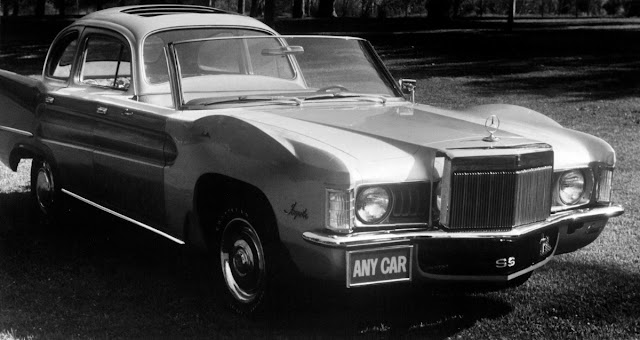Mixing parts of different cars in one project has always been the basis for creating hot rods. The goal is quite simple: install a much more powerful engine in a smaller car to drive faster, or use a bumper and grille from another model to look cooler. However, for several cars made in the 1970s, mixing parts was the main goal.
 |
| The AnyCar Loan ad from Manufacturers Hanover, 1973. |
One of the greatest example is the AnyCar. The creators tried to use in appearance as much as possible elements from different cars. Three different models were made: AnyCar I, AnyCar II and AnyCar III. They were created for shooting commercials of Manufacturers Hanover Trust New York Bank, which in the early 1970s wanted to promote its car loan program.
AnyCar I (1971)
Described as a new luxury/economy/intermediate automobile, the AnyCar was introduced to the auto-buying public on September 7, 1971. One of the nation’s leading banks, Manufacturers Hanover Trust Co. said it introduced the ForChevAmChrysVagen — or AnyCar as it was more commonly known — to emphasize the diversity of choice available to car purchasers.
Featuring“something for everybody” styling, the AnyCar is a unique blend of 22 different cars — ranging from Volkswagen to a Lincoln Continental.
It was powered by a Mercury 289 no in V8. Highlighted is the “modest flower print” of interior upholstery.
Released on November 3, 1972 the AnyCar II was also created by Gene Winfield and this time combined parts of 50 cars dating from the 1930s to 1970s.
The body from a 1929 Hudson provided the basis for the project. As daringly distinctive as its predecessor, it was introduced to the auto-buying public by Manufacturers Hanover Trust as focal point of its f all auto loan program.
It includes elements from a 1973 Triumph, 1973 Toyota, 1958 Volvo, 1970 Pontiac, 1961 Imperial, 1970 Mustang, 1970 Catalina, 1973 Mercedes, 1971 Dodge, 1969 Cadillac, 1954 Chrysler, 1969 Toronado, 1973 Plymouth, 1967 Volkswagen, 1968 Ford, 1961 Valiant, 1966 Corvette, 1971 Mach I, 1971 Continental and the aforementioned 1929 Hudson.
Here’s how they did it:
1. Valiant fender is fitted to Hudson body. Before rear fender assembly is completed, part of 1934 Ford fender will be joined to Valiant fender. Winfield had to design sheet metal fitting between door and Ford fender to obtain smooth joint. Rear of frame also had to be lengthened 75mm so door could open and close.
2. Sheet metal components are temporarily positioned before permanent assembly is made. Toronado front fenders actually “back up” ’69 Cadillac fenders in final assembly. AnyCar running gear has been “modernized” at this point with axle and brake drums from ’67 Chevy Van. Radiator has been installed and side spare wheels mounted. Radiator had to he moved four times to accommodate Bonneville hood.
3. As sheet metal work nears completion, dramatic contrast between low modern lines and statuesque classic lines is evident. Fenders and trunk have been assembled. Trunk lid is from ’51 Chevy with simulated spare tyre enclosure from Mark III Lincoln Continental kit.
4. Sheet metal assembly has been completed and car has been prime coated. (Before it rolled out of Winfield’s shop, AnyCar II had eight coats of paint.) Cadillac sidelights (’68) and front bumper ends (’70) plus Imperial headlight pods (’61) as well as ’58 Dodge center grill bumper bars have been added. Final step is wiring of engine, lights, heater and air conditioning.
AnyCar III (1975)
The third and final AnyCar was built by George Barris who made many of the vehicles for movies and television shows. Ever the showman, he based the AnyCar III on a 1974 Volkswagen wagon so he could free up the area under the front bonnet for a small battery-powered car that could be detached and used as a run around.
It includes parts from from about 40 other cars (Cougar, Mercury, Cadillac, VW, MG, New Yorker, Volvo, Jaguar, Lucas, Chevrolet, Toyota, Continental, Ford, Marcal, Matador and others). The styling is completely asymmetric.
No specific component is dominant and you simply cannot find two paired elements. Under the hood, there was a tiny Mini-AnyCar electric car designed for traveling short distances. At the touch of a button it automatically lowered out of the main car along with a Rolls-Royce grille.
“A car for all times” does not pollute the environment and minimizes the fuel crisis and traffic problems in urban areas.
The Mini-AnyCar measured 760x680x610mm and weighed 135kg.





















0 comments:
Post a Comment